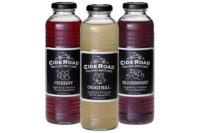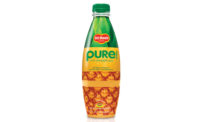Natural foods retailers face competition from other channels
Beverages experience mixed bag of results in specialty channel

American consumers’ desires for organic products continue to gain steam. According to data from the Washington, D.C.-based Organic Trade Association (OTA), sales of organic products reached $35.1 billion in 2013, an increase of 11.5 percent compared with the previous year. Of those total sales, organic foods and beverages represented 92 percent at $32.3 billion. Organic beverages accounted for approximately 12 percent of total organic food and beverage sales at $4 billion, the OTA notes.
Although organic food and beverage sales are faring well, the retail channels associated with them are seeing increasing competition from traditional channels such as supermarkets, mass merchandisers and drug stores. According to Rockville, Md.-based Packaged Facts’ July report “Natural and Organic Foods and Beverages in the U.S., 4th Edition,” mass-market retail outlets will account for 49 percent of dollar sales for natural and organic foods and beverages in 2014. In comparison, the natural foods channel, which includes Whole Foods Market, Trader Joe’s, smaller regional natural foods chains, and independent natural foods stores, will account for 41 percent.
Los Angeles-based IBISWorld also calls out the external competition that specialty retailers are facing. In the market research firm’s March report “Specialty Food Stores in the US,” it states that major grocery store chains are able to leverage economies of scale to help lower costs, while online retailers can capitalize on low overhead costs to offer a competitive advantage. “External competition is expected to increase slowly during 2014, indicating a potential threat to the industry,” the report states.
Despite this increased competition, IBISWorld notes that specialty retailers do benefit from the specialized nature of their assortments, which result in higher profit margins than traditional grocery outlets. For 2014, the market research firm estimates that the channel will earn a profit of $240.1 million, accounting for 3.1 percent of total revenue. It also estimates an annualized revenue increase of 1.3 percent during the five-year period to 2019.
“Consumer sentiment and disposable income are forecast to rise, prompting consumers to spend more on the industry’s premium and gourmet products,” the report states.
New York-based Nielsen tracks the premiere fresh grocery channel as a sub-division of the supermarket grocery channel. “The supermarket grocery channel includes natural and organic retailers as well as other supermarkets that focus primarily on fresh foods,” says Joanna Parker, director of Nielsen’s perishables group. “It continues to grow as we see an increase in overall trips versus a year ago.”
Parker adds that health is the next biggest concern for consumers, following the economy, and the premiere fresh grocery channel is able to capitalize on that interest. “However, a barrier to entry is the often higher price points associated with this channel,” she says.
Thirsting for sales
For beverages, performance within these specialty outlets could be described as a bit of a mishmash. “It’s a mixed situation where [fruit juice and fruit juice blends] are not necessarily gaining new buyers, but those who do buy are purchasing more often, leading to a growth in spending,” Parker says.
For example, the number of consumers who visit this channel and buy produce beverages — fruit juices and fruit juice blends that are merchandised in the produce department — is down 12 percent this year, but sales from existing consumers are increasing and are up 19 percent from the previous year, Parker explains. She adds that consumers in this channel also have increased the amount they spend each year by 20 percent to $13.82.
However, external competition is affecting produce beverage sales at premiere fresh grocery stores. Dollar sales declined from $39.1 million in the 52 weeks ending June 29, 2013, in Nielsen-measured channels, to $36 million in the 52 weeks ending June 28. “Shoppers are spending less of their produce beverage dollars at premiere fresh grocery stores and more at conventional grocery stores,” Parker says.
Within the specialty food stores channel, premium beverages have fared well. IBISWorld estimates that coffee and tea sales will account for 5 percent of the channel’s sales in 2014 as retailers offer specialized coffees and teas, such as gourmet varieties and rare blends, versus the larger, more popular brands found at grocery stores, the report notes. “Therefore, these are premium stores dedicated to the more sophisticated and avid coffee and tea drinkers,” the report notes. “In the past five years, market share has increased for this segment of the industry, with rising disposable income allowing consumers to indulge in this affordable treat.”
Beverage-makers also are leveraging their relationships with natural foods retailers. For example, Honest Tea, an independent operating unit of Atlanta-based The Coca-Cola Co., released its limited-edition Summer Refreshers line exclusively at Whole Foods Market locations nationwide. Federal Way, Wash.-based Fresh Matters LLC also strengthened its ties with the Austin, Texas-based retailer. The company launched four new cold-pressed, high-pressure-processed ‘tude juices exclusively at 166 Whole Foods Market stores in the Pacific Northwest, northern California, Southern Pacific, Rocky Mountain and Southwest regions during July and August in advance of their nationwide release in September.
“We are really excited about the new fresh juice blends and our partnership with Whole Foods,” said Co-founder Andy Knowlton in a statement. “Whole Foods distribution means a lot to us, especially because we are a small, young company.”
Nielsen’s Parker explains that distribution within the premiere fresh grocery channel allows for not only expanded distribution points but also an ability to reach new consumers and specialty buyers who primarily shop in that channel.
Consumer understanding
Within the specialty retail channel, consumer demographics have some distinct points of differentiation, experts note.
“Across the total U.S., shoppers in the premiere fresh grocery channel are more likely to be from affluent households,” Parker says. “Female heads of households under 35 also index higher in the natural and organic retailer channel.”
IBISWorld notes similar consumer demographic labeling. The market research firm found that consumers aged 18-35 are expected to account for 34.5 percent of specialty food store revenue in 2014. This makes it the largest group, as consumers aged 36-50 are estimated to account for 29.5 percent in 2014, and those aged 51 and older are expected to account for 17.5 percent.
For the consumer age group between 18 and 35 years old, IBISWorld reports that these consumers are the most likely to adopt new food and beverage products and are more likely to have the highest amount of discretionary income available for products within specialty food stores.
The market research firm notes a similar description for the 36-50 age group. “Consumers in this category can often afford higher-priced goods such as gourmet foods and other specialty items,” it states. “Similar to consumers aged 18-35, consumers in this group have also been early adopters of organic and natural foods and beverages because of their proposed health benefits.”
When it comes to organic sales, IBISWorld notes that organic food sales are expected to continue to rise in the next five years and beyond. Citing the U.S. Department of Agriculture (USDA), the report states that organic food is by far the fastest-growing industry in the food segment, accounting for 4.2 percent of all sales. It is expected to reach 5 percent by 2019 based on current growth rates. But as previously noted, supermarkets and other external competitors are expected to carry more organic foods too.
Packaged Facts also notes consumers’ propensity to buy natural or organic products. Citing data from a webinar by Chicago-based Information Resources Inc. and Schaumburg, Ill.-based SPINS, it notes that 97 percent of U.S. consumers buy natural products, while 70 percent buy organic. However, Packaged Facts points out that while the USDA has strict requirements when it comes to organic labeling, natural labeling is more ambiguous, as the U.S. Food and Drug Administration does not specifically define natural products except for restricting certain ingredients that are artificial or synthetic.
Looking for a reprint of this article?
From high-res PDFs to custom plaques, order your copy today!






